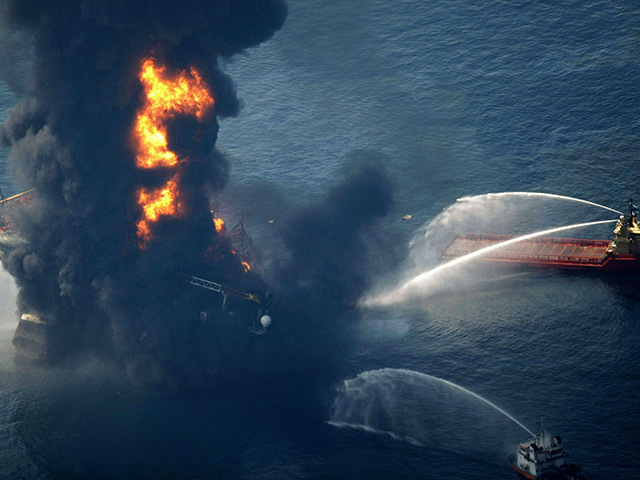
The record $18.7billion Deepwater Horizon settlement is, first and foremost, a victory for BP. The company’s shareholders clearly recognize this. After the settlement was announced Thursday, giddy investors sent the company’s shares up more than 5%, adding more than $5billion to its market value.
That’s almost enough, from a single day of trading, to cover the all the Clean Water Act fines included in the settlement. Those $5.5billion in fines, which by the way, were less than half what BP could have faced after a federal judge found the company grossly negligent in the accident, which killed 11 men in 2010.
That doesn’t mean that BP is getting off easy. The settlement adds another $10billion to the $44billion or so that the company has already spent on legal costs, settlements and cleanup. That makes the tab, so far, more than the profit it’s earned since 2012, and analysts predict that resolving the private lawsuits that remain could cost another $10billion or so.
The settlement’s 15-year time frame means that BP will be paying only about $1billion a year, which is a manageable for a company its size. It also has a year before it has to start making payments, and it can deduct the settlement from its taxes, further easing the financial burden.
Far from letting BP off easy, the structure of the settlement was intentional. Much of the money will be used to restore the Gulf Coast, both financially and environmentally. Organizations that will use that funding can plan long-term projects knowing that they will be supported by a steady revenue stream.
The government also was wary of extracting too high a price from BP too quickly. After all, if the punishment forces BP into bankruptcy, there’s less chance of receiving the full settlement.
For both sides, the agreement means an end to protracted litigation. A judge’s ruling would have sparked appeals from one side or the other, with no guarantee of a better outcome. From the beginning, this was a case that seemed destined to settle.
Having spent the past five years shedding some $43billion in assets to pay legal costs, BP can now begin to focus on rebuilding. It remains the weakest member of its peer group, the poorest performer among the majors in terms of stock price.
Takeover speculation has swirled for years, and with the cost of the settlement now known, BP’s remaining assets and weak oil prices make it a prime target. Thursday’s jump in its shares shows many investors are betting a suitor will come calling.
While resolving the case is a victory, it’s a small one compared with the magnitude of the opportunities BP has lost in the past five years.
As news of the settlement broke, I found myself thinking back to the first time I interviewed Tony Hayward, shortly after he became BP’s CEO in 2007. At the time, the company was full of hope and oil prices were rising. Hayward had vowed to implement safety reforms after the lapses that led to 15 deaths and more than 170 serious injuries in an explosion at its Texas City refinery two years earlier. BP’s technological marvel, the Thunder Horse platform in the Gulf of Mexico, had been repaired after nearly sinking and was set to begin production. Hayward said he wanted to make BP a “great operating company.”
Today, BP is far smaller than it was then. Oil prices have slumped and are likely to remain below pre-Macondo levels for years to come. After slashing assets to pay settlement costs, BP is now slashing some $2billion to $3billion in expenses and thousands of jobs to offset declining revenue from the crude collapse.
These costs pale compared with the other fallout from the accident. The families of the victims continue to struggle with the loss of loved ones, and some survivors still suffer physically and emotionally. Fishermen and other business owners saw their livelihoods upended, and the Gulf of Mexico itself, while demonstrating remarkable resilience, shows lingering scars, too.
All of the opportunity the company lost, and all of the hardship the accident has brought on those affected by it will be meaningless if BP and the industry as a whole don’t change the approach to safety. That will be even more difficult with oil prices 40% below their mid-2014 level.
Part of BP’s strategy in responding to the Deepwater Horizon accident was to avoid the endless legal proceedings that engulfed Exxon after the Valdez accident in Alaska. In some ways, it has succeeded in that by wrapping up the major litigation in five years. Yet Exxon’s own internal investigation of the Valdez disaster prompted it to fundamentally change its safety culture across the company, and today, Exxon is considered the gold standard for safety in the industry. By contrast, BP’s internal investigation of Macondo whitewashed the root causes.
This is BP’s biggest post-Macondo challenge: changing its culture to avoid the missteps that led to the explosion aboard the Deepwater Horizon five years ago. It will be far more difficult than paying fines and penalties.
The company says that it knows this and has already made great progress. It has said it before. Talk of change was everywhere in 2007, and it spilled from the lips of Tony Hayward like so many drops in the ocean.
This time, it must. Just as Exxon once did, BP must reinvent itself as an example for safety. If it does, then the settlement will be a victory not just for the company, but for anyone else who works – or will ever work – on an offshore rig.
Loren Steffy is a managing director with the communications firm 30 Point Strategies. He is a writer at large for Texas Monthly, a contributor to Forbes and the author of Drowning in Oil: BP and the Reckless Pursuit of Profit and The Man Who Thought Like a Ship. Follow him on Twitter: @lsteffy; on Facebook or at lorensteffy.com.
Recommended for you
